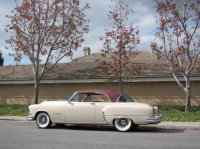So, I recently got a 1953 Lincoln Capri, which is in great shape. Another pillarless coupe without AC!
Link to photo:
http://stableltd.com/index.php?opti...=517&catid=98&makeid=146&modelid=0&Itemid=177
Car has a stock 317 Lincoln Y block V8 with a four speed automatic manufactured by GM (Ford did not have the transmission technology that GM did, so they had to buy them from their competitor). 205hp. These were the cars that won the stock class in the Carrera Panamerica in the early 50s.
However, it runs a little warm, and I want to beef up the cooling system for our Florida climate. It has six volt electrics and is all stock.
Options for upgrades-
1.remove the stock water pump and try to rebuild and optimize its performance.
2. Put in an electric fan. There are six volt electric fans on the market, but do they work well? Should I convert to 12V and run a 12V fan?
3. Have a custom radiator fabricated out of aluminum.
4. Any other options?
What should I do first?
The other issue is that warm restarting can be a problem. Has a big Holley 4 barrel downdraft carb right in the center of the cast iron manifold. The gas is probably boiling in the carb. There is already a spacer placed in between the manifold and the carb. So, the next step is probably to install and electric fuel pump to draw cool fuel into the carb and keep the fuel from boiling. Any other thoughts?
Thanks in advance.
Scott
Link to photo:
http://stableltd.com/index.php?opti...=517&catid=98&makeid=146&modelid=0&Itemid=177
Car has a stock 317 Lincoln Y block V8 with a four speed automatic manufactured by GM (Ford did not have the transmission technology that GM did, so they had to buy them from their competitor). 205hp. These were the cars that won the stock class in the Carrera Panamerica in the early 50s.
However, it runs a little warm, and I want to beef up the cooling system for our Florida climate. It has six volt electrics and is all stock.
Options for upgrades-
1.remove the stock water pump and try to rebuild and optimize its performance.
2. Put in an electric fan. There are six volt electric fans on the market, but do they work well? Should I convert to 12V and run a 12V fan?
3. Have a custom radiator fabricated out of aluminum.
4. Any other options?
What should I do first?
The other issue is that warm restarting can be a problem. Has a big Holley 4 barrel downdraft carb right in the center of the cast iron manifold. The gas is probably boiling in the carb. There is already a spacer placed in between the manifold and the carb. So, the next step is probably to install and electric fuel pump to draw cool fuel into the carb and keep the fuel from boiling. Any other thoughts?
Thanks in advance.
Scott

